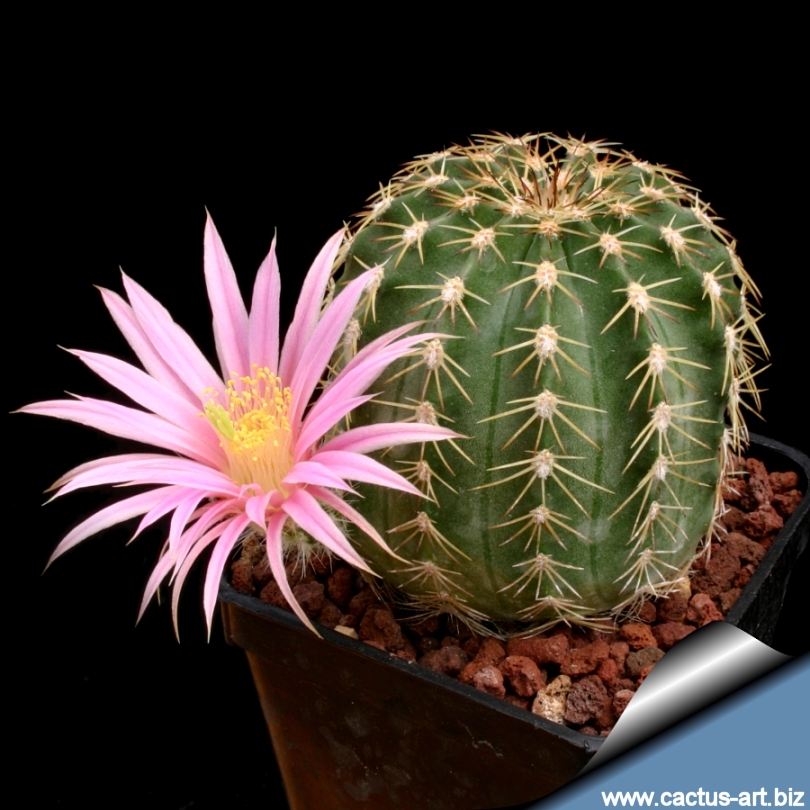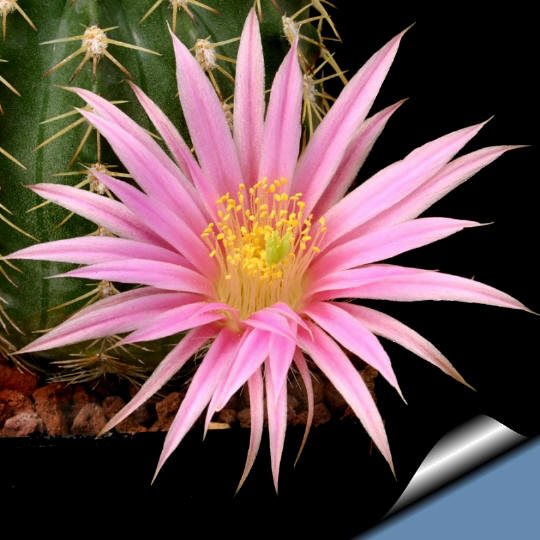|
|
|

E. pulchellus var. weinbergii is very popular in collections, and
bears many spectacular big pink flowers.
|
|
Description: Solitary or
slowly clumping
Stems: Flat globular, conical as it
ages, up to 13 cm in diameter (but cultivated plants
are frequently larger), bluish green when young;
Ribs: 14 or 15, acute
Areoles: 5 to7 mm apart; 3 to 7
Central spines: Not
present.
Radial spines: 8 to 11 spines per areole, 3-12 mm
long, pale yellowish.
Root: It has a strong taproot.
Flowers: Abundant pink or purple/red (rarely white) flowers, up
to 6 cm in diameter.
|
Photo of conspecific
taxa, varieties of Echinocereus pulchellus.
- E. pulchellus ssp. pulchellus has stems that are
2,5-5 cm thick, with 9 to 12 ribs and 3 to 7 inconspicuous spines per
areole. The flowers are pink or white.
-
E. pulchellus ssp. acanthosetus has stems that are 2 to
4cm thick, usually with 9 ribs and 5 to 8 flailing hairlike spines.
The
flowers are magenta to white.
E. pulchellus ssp. sharpii has darker colored
stems in comparison to the other subspecies, that are 2 to 6cm thick
with 11 to 17 ribs and 7 to 14 spines per areole. The flowers are
magenta to white.
- E. pulchellus ssp.
weinbergii has stems that are 5 to 15 cm thick, with 14 or
15 ribs and 8 to 11 spines per areole. The pink diurnal flower petals
are narrowly
acute in shape.
-
E. pulchellus ssp. amoenus has 15 cm stems, 10 to 14 ribs,
and on the young areoles it has 6 to 8 short spines with the lower spine
being the longest. The older areoles are devoid of spines. The flowers
are magenta.
Form & Cultivars:
Cultivation: It has a strong tap root and
should have a deep pot to accommodate it. It needs porous well-drained
soil. Water carefully;
too much water will make it rot.
Keep dry at
minimum temperature of 5° C in winter, although
it will tolerate brief
periods down to -10 degrees. Sun Exposure: Full sun to light shade.
Propagation: It grows easily from seeds or cuttings (if available)

 |
|
Advertising
|
|
|
|
|
Family:
Cactaceae (Cactus
Family)
Scientific name:
Echinocereus
weinbergii Weing.
Origin: Mexico (Zacatecas)
Conservation status: Listed in
CITES appendix 2.
Ecology: It is a geophyte
cactus with a swollen underground storage taproot.
In the wild it tends to disappear completely in the ground, in times of drought.
|
Synonyms:
- Echinocereus pulchellus ssp. weinbergii (Weing.)
N.P.Taylor
- Echinocereus weinbergii,
- Echinocereus pulchellus ssp. venustus
|
|
|
|


|
|